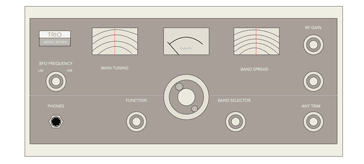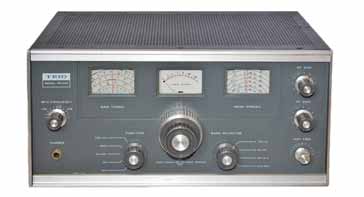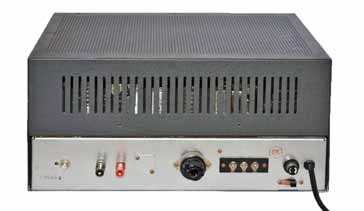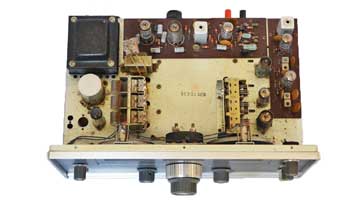Trio (Kenwood) 9R-59DE Vintage Communications Radio
The Trio 9R-59DE was a valve / tube short wave communications radio aimed at the amateur radio and short wave listener market in the late 1960s & early 1970s.
Trio / Kenwood Radios Includes:
Trio 9R-59DE
Iconic radio receivers:
Summary of iconic radio receivers
Radio receiver history
Crystal radio sets
Development of the superhet radio
Radio history / timeline
The 9R-59DE radio was produced by the Trio company (now Kenwood) between 1969 and 1974. This vintage radio communications receiver was also produced in other versions, namely the 9R-59D and the 9R-59DS, but there appears to be little difference between them.
Although it is now what would be termed a vintage radio, it was very popular at the time of its manufacture, meeting the needs of many short wave listeners and a number of radio amateurs or radio hams. Advertisements were widely seen for it across the amateur radio and short wave listener magazines of the time.
The radio gained a good name for itself, and was one of the many radios of the beginning of the era of Japanese radios that took over and dominated the market around this time.

Trio 9R-59DE summary & specification
The 9R-59DE vintage radio was an 8 valve or tube single conversion superhet radio covering 0.55MHz to 30 MHz in four bands. Although a general coverage radio, the 9R-59DE incorporated a calibrated electrical band-spread feature for the amateur radio bands
The radio had quite reasonable selectivity for its time using a mechanical filter, and it also included a product detector for improved SSB and CW reception.
The receiver manual describes the receiver tuning as and band-spread as providing easy to read dials for both the main tuning and band-spread and the mechanism provides an anti-backlash movements.
It also highlights the fact that the receiver has one RF and two audio stages of amplification. An automatic noise limiter, ANL is also provided and antenna trimmer is included to enable optimum sensitivity on all bands.
The receiver is also equipped with a standby switch, enabling it to be used alongside a ham radio transmitter.

The radio is also unusual in that it provides space and connections, etc for the owner to build in some additional features like a crystal calibrator and to add a voltage stabiliser to improve the frequency stability of the radio.
| Trio 9R-59DE Performance Summary |
|
|---|---|
| Parameter | Details |
| 9R59DE summary | Single conversion mains or line powered superhet covering 0.55 to 30 MHz in four bands. |
| Frequency bands | Band A: 0.55 - 1.6 MHz Band B: 1.6 - 4.8 MHz Band C: 4.8 - 14.5 MHz Band D: 10.5 - 30 MHz |
| Reception modes | AM, SSB, CW |
| Antenna input | SO239 / 50Ω |
| Sensitivity | 2µvolts for 10dB S/N ratio |
| Intermediate frequency | 455 kHz |
| Selectivity | ± 5kHz @ -50dB |
| Dimensions | 38 cm wide x 17 cm high x 26 cm deep |
| Weight | 8 kg |
| Power requirements | 110 - 120 / 220 - 240 VAC 50/60Hz @ 45W |
9R-59DE circuit description.
The Trio 9R-59DE vintage radio circuit uses an eight valve of tube line-up, although an additional voltage stabiliser can be added by the user or owner if needed, bring the valve complement up to nine.
The circuit is relatively straightforward, but it includes a number of nice touches and capabilities.
| Valve Line-up for Trio 9R-59DE Radio Receiver Circuit |
||
|---|---|---|
| Valve Number | Type | Use within the circuit |
| V1 | 6BA6 | RF amplifier |
| V2 | 6BE6 | RF mixer |
| V3 | 1/2 6AQ8 / ECC83 | HF oscillator |
| V4 | 6BA6 | 1st IF amplifier |
| V5 | 6BA6 | 2nd IF amplifier |
| V6 | 6BE6 | Product detector |
| V7 | 6AQ8 / ECC83 | BFO & 1st AF amplifier |
| V8 | 6AQ5 | AF output |
| Optional addition | OA2 | Voltage regulator |
The overall circuit is relatively straightforward, with a line-up of easy to obtain valves / tubes. Even these days, these types are not nearly as difficult as some to obtain.

The radio can be split down into its main circuit blocks:
• RF amplifier: The RF amplifier employs a 6BA6 valve / tube in common with many other vintage communications receivers of this time.
The manual stated that the design had placed special emphasis on obtaining good RF selectivity to enable a high level of image rejection and a good signal to noise ratio.
• HF local oscillator: The HF oscillator performance was key to the overall way in which the radio performs - in particular its frequency stability is very important.
The oscillator circuit within this vintage radio uses the low inter-electrode capacitance in a Hartley oscillator configuration to ensure the optimum stability. Using this approach is essential because the oscillator needs to cover a wide frequency range.
Other circuit feature that helps with the stability is that a reaction coil is included in the anode circuit to maintain stable oscillation without parasitics above 20 MHz. Additionally a 68 Ω is used to prevent too much feedback being present which will give rise to instability.
• RF mixer circuit: The mixer circuit is also important as it needs to provide linear frequency transitions for the incoming signals. If the circuit becomes non-linear, then unwanted intermodulation products and spurious signals will be present.
The coupling between the oscillator and mixer has been minimised using a small value coupling capacitor to ensure that any loading and frequency shift on strong signals does not occur.
In addition to this, V2, the 6BE6 RF mixer uses a grid excited mixer circuit topology to maximise the conversion gain.
Also as would be expected, the AGC line is not applied to the mixer to ensure the optimum working conditions at all times.
• IF amplifier: The IF amplifier is the section of any superheterodyne radio, vintage or otherwise, where the majority of the gain is provided along with the adjacent channel selectivity.
To achieve the required level of gain, two amplifier sections are used, both based around a 6BA6 with transformer coupling between the two stages and also on the output.
To provide the required selectivity a mechanical filter is used on top of that provided by the IF transformers. This gives much superior selectivity to that provided by the use of only the tuned IF transformers, enabling the receiver to cope with the crowded band conditions of its day. The mechanical filter is located at the input to the IF stages, thereby preventing overloading by strong off-channel signals..
• Signal demodulation: Two separate detectors are used dependent upon the mode of transmission being received.
For amplitude modulation a simple envelope detector is employed which consists of a semiconductor diode.
For SSB and CW, a product detector (based around a 6BE6) and an associated BFO (based around half of a 6AQ8).
The BFO has frequency adjustment to enable it to be positioned correctly for upper sideband, lower sideband and CW as the signal itself needs to be centred around the passband of the IF filter.
• Audio stages: There are two stages of audio amplification. The first is effectively a pre-amplifier provided by half a 6AQ8. The second stage is provided by the output valve / tube, a 6AQ5. This provides a maximum of about 1.5 watts output to a loudspeaker via an audio transformer.
• Line power supply: This vintage radio communications receiver uses two silicon diodes to provide the full wave rectification with a centre taped mains transformer. Smoothing is provided by capacitors.

9R-59DE additional options
This vintage radio communications receiver has the unusual approach of encouraging owners to add their own modifications.
There is a socket for an additional vale - an OA2 voltage stabiliser for the HF local oscillator as well as the beat frequency oscillator.
In addition to this ready drilled holes are available to add a valve / tube based crystal calibration oscillator and a circuit for a transistorised version is even given in the handbook.
In terms of Trio supplied extras, there was a matching 8Ω loudspeaker available if required. That said, many people would use their own if one was available.
The Trio 9R-59DE is a vintage radio that was very popular in its day, being one of several from the Trio stable that stamped the company name on the amateur radio market around the globe.
The radio performed well, although by today's standards it would lack some of the refinements that modern technology could provide. Nevertheless it is a radio that is still popular with many enthusiasts today and a good number are seen on the second user markets where they are reasonably well sought after.
 Written by Ian Poole .
Written by Ian Poole .
Experienced electronics engineer and author.
More History:
Radio history timeline
History of the radio
Ham radio history
Coherer
Crystal radio
Magnetic detector
Spark transmitter
Morse telegraph
Valve / tube history
PN junction diode invention
Transistor
Integrated circuit
Quartz crystals
Classic radios
Mobile telecoms history
Vintage mobile phones
Return to History menu . . .




